
How to Write a Midwife Cover Letter: With Examples, Tips and Templates
In addition to your midwife CV, your cover letter is your chance to deliver the perfect career story: why you’re applying for the midwife position, how your skills in midwifery practice stand out, and how you provide safe, compassionate, patient-centred care.
A well-written cover letter can significantly increase your chances of being noticed. Whether you’re applying as a graduate midwife, a student, an experienced nurse, or stepping into a manager role, this guide will help you write a letter that makes a strong impression.
In this article, we cover:
Must-have sections for a midwife cover letter
Midwife cover letter examples and templates for different roles
Mistakes to avoid when writing your letter
How to write a midwife cover letter with no experience.

Midwife cover letter example
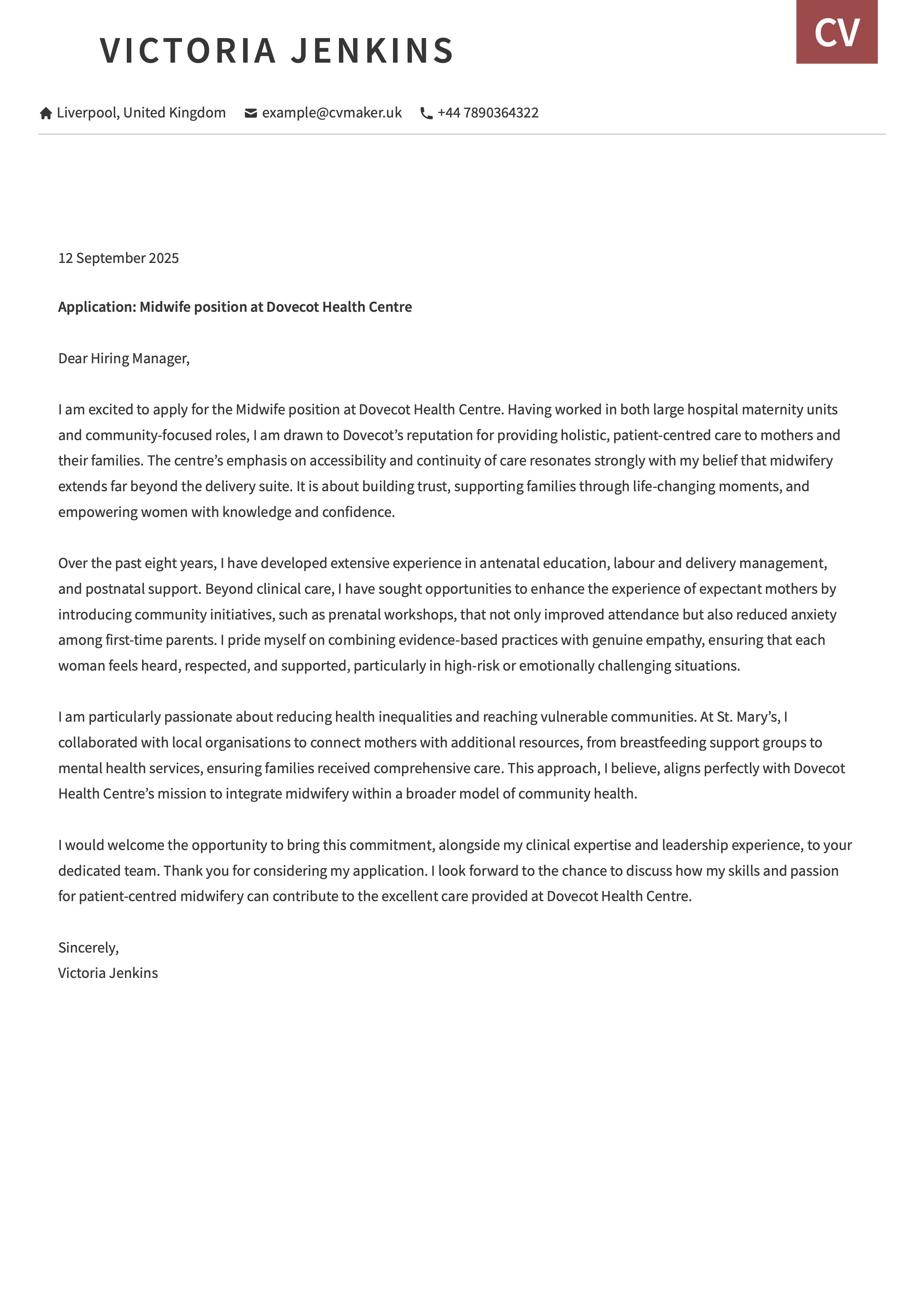
Download this free midwife cover letter example in PDF.
Why does this cover letter template work?
It follows a clear and professional structure, with personal information at the top and the cover letter itself centred.
It presents the candidate's experience in an organised manner, with an easy-to-navigate layout.
It blends professional achievements with soft skills like compassion and empathy.
How to format a cover letter for midwife jobs
Think of your cover letter structure as your first conversation with the employer. It should flow logically, highlight your most relevant skills, and show genuine enthusiasm for this rewarding career.
Must-have cover letter sections
Personal details: Include your full name, contact information, and location.
Introduction: Start with a greeting, then provide a concise yet compelling introduction.
Body: Highlight pertinent expertise and abilities, incorporating noteworthy achievements if applicable.
Conclusion: Summarise everything into a brief paragraph, followed by a professional sign-off.
Learn more about how to write a good cover letter.
What to include in your midwife cover letter:
Header: Full name, location, phone number, professional email.
Greeting: Address the hiring manager by name if possible (e.g. Dear Ms Carter). If not, use “Dear Hiring Manager.”
Introduction: State the midwife role you’re applying for and highlight your background.
Body: Showcase your experience in prenatal care, labour and delivery, or postpartum care, as well as your soft skills.
Conclusion: Express interest, thank the employer, and invite further discussion.
Sign-off: Use “Sincerely,” or “Kind regards,” followed by your full name.
Pro tip
Align your CV and cover letter to share a consistent format, tone, and design. This creates a polished and professional impression.
How to write a good cover letter introduction for midwife roles
Your cover letter opening paragraph is where the connection starts. It should be clear, confident, and show your enthusiasm for the role.


Recommended things to include in your cover letter introduction:
The exact role you’re applying for.
Your current or most recent job title.
Areas of midwifery practice you specialise in.
Years of experience.
A relevant achievement or responsibility.
Midwife cover letter introduction examples
Midwife nurse cover letter introduction example
I am writing to apply for the Midwife position at Guy’s and St Thomas’ NHS Foundation Trust. With over 6 years of experience as a nurse and midwife in London, including work in the labour ward and hospital birth centres, I have successfully managed high-risk pregnancies and delivered patient-centred care using evidence-based practices for expectant mothers and their families.
Midwife graduate cover letter introduction example
I am thrilled to apply for the Graduate Midwife role at Queen Elizabeth Hospital. Having recently completed my BA in Midwifery and clinical placements at Birmingham Women’s Hospital, I have developed strong skills in prenatal care, labour and delivery, supporting mothers and their families with compassion and professionalism.
Midwife manager cover letter introduction example
With over 10 years of experience in midwifery practice, I am excited to apply for the Midwife Manager position at Leeds Teaching Hospitals NHS Trust. I have successfully managed teams in maternity services, stewarded professional development programmes, and led improvement initiatives in postpartum care and antenatal services.
Student midwife cover letter introduction example
As a final-year Student Midwife at Cambridge University Hospitals NHS Foundation Trust (Rosie Hospital), I am very keen to apply for the midwife position at your maternity unit. My training has included assisting in labour and delivery, supporting mothers with prenatal and postnatal care, and working closely with mentors on evidence-based practices and high-risk pregnancies.
How to write a cover letter body for a midwife role
The body of your cover letter should expand on your introduction. Use one to three paragraphs to show your skills, clinical expertise, and commitment to midwifery.

Pro tip
Use numbers or examples to illustrate achievements (e.g. “supported over 200 deliveries”).
Tips for a good midwife cover letter body:
Show how you deliver safe, evidence-based care.
Highlight teamwork with doctors, nurses, and health visitors.
Demonstrate empathy and communication with mothers and families.

How to tailor your cover letter body for specific roles:
Hospital midwife: Highlight acute care, emergencies, labour and delivery.
Community midwife: Focus on continuity of care, home visits, and education.
Midwife manager: Stress leadership, staff development, and service improvement.
Midwife cover letter body paragraph examples
Midwife nurse cover letter body example
In my current role at St Thomas’ Hospital, I have supported over 200 deliveries, ranging from routine births to complex high-risk pregnancies. I have delivered prenatal care, guided mothers through labour and delivery, and overseen postpartum care. My role also involves coordinating with multidisciplinary teams, implementing evidence-based practices, and supporting professional development among junior colleagues. These experiences have strengthened my ability to deliver holistic, safe, and compassionate care to mothers and their families.
Midwife graduate cover letter body example
During my training placements, I worked alongside senior midwives in antenatal clinics, labour wards, and community health centres. I assisted with monitoring foetal wellbeing, supporting labour and delivery, and delivering postnatal care. I also gained experience supporting mothers during breastfeeding and counselling families through birth planning. These opportunities have prepared me to step confidently into a graduate role, applying evidence-based practices while continuing my professional development.
Midwife manager cover letter body example
In my recent role as Lead Midwife at Sheffield Teaching Hospitals NHS Foundation Trust, I successfully managed a team of 15 midwives across labour wards, antenatal clinics, and community hubs. I introduced evidence-based practice training, coordinated audits of maternal outcomes, and implemented improved pathways for high-risk pregnancies. Under my leadership, patient satisfaction scores increased, and staff engagement improved due to my commitment to professional development and mentoring.
Student midwife cover letter body example
Throughout my clinical placements at the Rosie Hospital, I gained hands-on experience in antenatal care, labour ward support, and postpartum visits in the community. I assisted in preparing delivery suites and offering emotional and physical support to expectant mothers. My experience working with high-risk pregnancies has taught me the importance of teamwork, communication, and evidence-based practice in delivering safe, compassionate care.

How to end a cover letter for midwife jobs
Your cover letter conclusion should summarise your strengths, reiterate your enthusiasm, and invite the employer to get in touch.
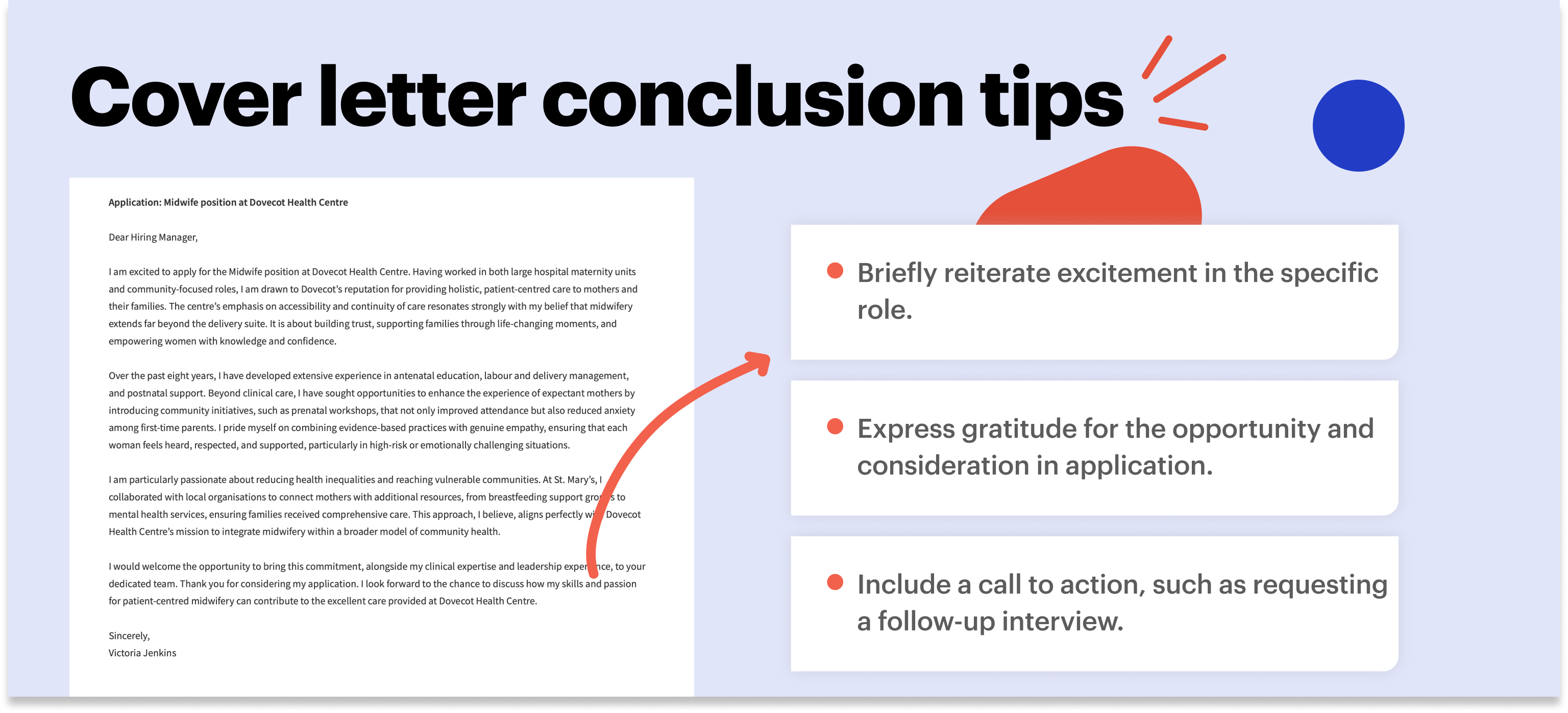
Midwife cover letter conclusion examples
Midwife nurse cover letter conclusion example
Thank you for considering my application. I would welcome the opportunity to bring my extensive experience in labour and delivery, prenatal care, and postpartum support to the maternity team at Guy’s and St Thomas’ NHS Foundation Trust. I look forward to the possibility of discussing how my skills and values align with your high standards of patient-centred care.
Midwife graduate cover letter conclusion example
Please find my CV attached. I am very enthusiastic about joining the maternity services at Queen Elizabeth Hospital, where I can contribute with my training, dedication, and commitment to safe, evidence-based midwifery practice. I look forward to the chance to discuss how I can support your team.
Midwife manager cover letter conclusion example
I believe my blend of leadership, clinical expertise, and dedication to professional development makes me a strong candidate for the Midwife Manager role at Leeds Teaching Hospitals NHS Trust. Thank you for your time and consideration. I am eager to explore how I could help drive high standards of care for mothers and their families in your maternity services.
Student midwife cover letter conclusion example
I am enthusiastic about the opportunity to begin my career within Cambridge University Hospitals NHS Foundation Trust, applying my training and commitment to patient-centred care. Thank you for considering my application; I look forward to the possibility of discussing how I can contribute to your maternity team and support mothers and their families.
How to write a midwife cover letter with no experience
If you’re applying as a student, recent graduate, or after a career change, follow these tips:
Highlight transferable skills: Emphasise communication, empathy, teamwork, and reliability from part-time work or volunteering.
Show passion for midwifery: Mention health and social care coursework, work experience in healthcare, or with families and children.
Emphasise willingness to train: Share your readiness to learn clinical skills, follow NHS protocols, and take guidance from senior staff.
Align with mission: Show enthusiasm for patient-centred maternity care and reducing health inequalities.
Midwife cover letter example without experience
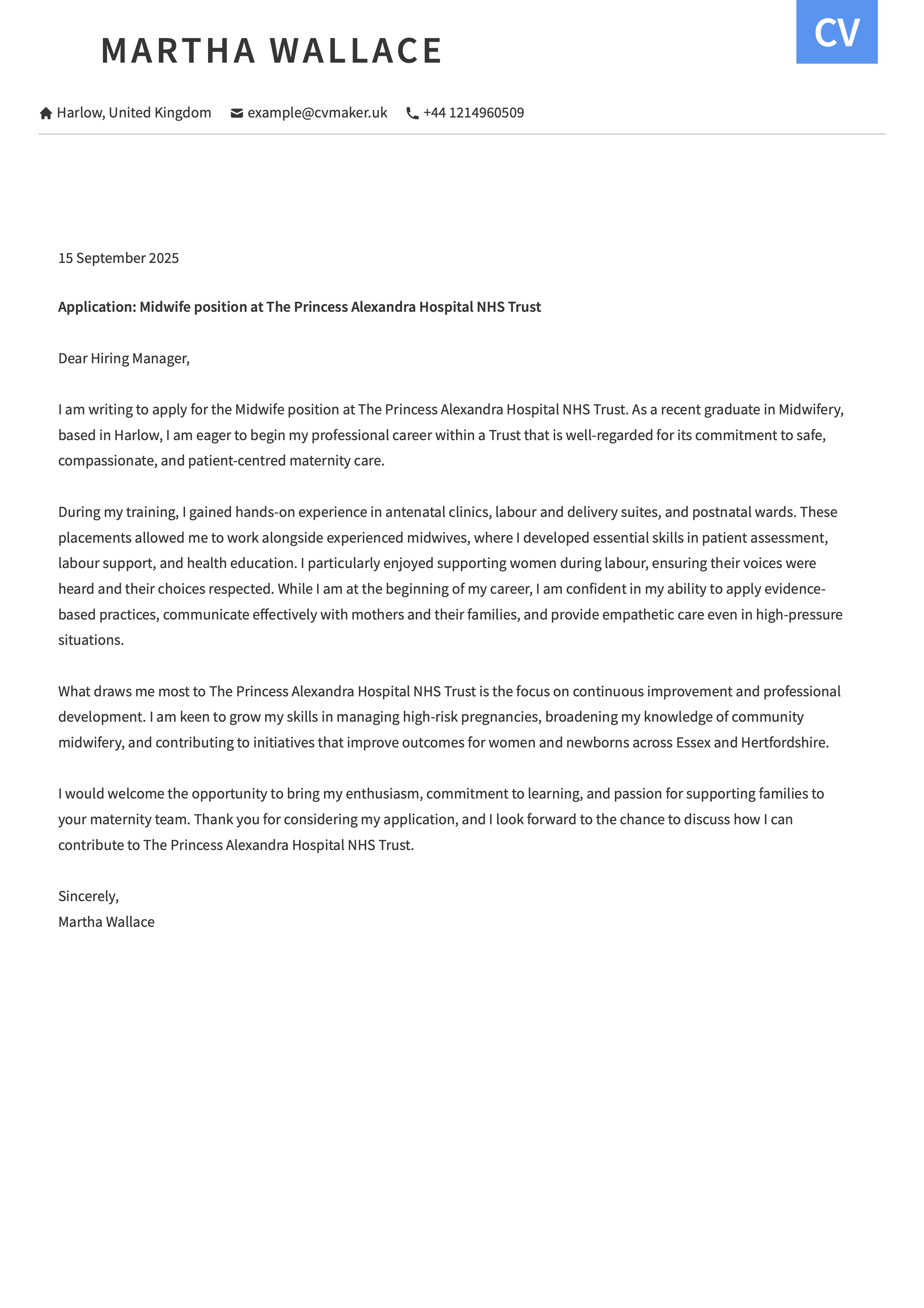
Download this free midwife cover letter with no experience in PDF.
Midwife skills for a cover letter
To stand out, showcase a mix of clinical expertise and interpersonal skills. Here are key qualities to highlight.
| Core clinical skills | Additional strengths |
|---|---|
| Prenatal care and education | Communication with mothers and their families |
| Labour and delivery support | Patient-centred care in hospitals, health centres, and birth centres |
| Postpartum care | Leadership and team management |
| Knowledge of high-risk pregnancies | Training and mentoring (for senior roles) |
| Evidence-based practices | Dedication to professional development |
Keywords for a midwife cover letter
Many healthcare employers use applicant tracking systems (ATS) to screen applications. So, to increase your chances of getting shortlisted for an interview, include keywords and industry-specific terms from the job description and mirror the employer's language.
Industry terms you can include
5 common mistakes to avoid when writing a midwife cover letter
When applying for a midwife position, employers expect professionalism, compassion, and a clear understanding of maternity care.
Avoiding the following cover letter pitfalls will help your application stand out for the right reasons.
1. Using vague openings
“I am applying for the Midwife position at Leeds Teaching Hospitals NHS Trust. With 5 years of experience supporting labour and delivery in both hospital and birth centre settings, I am confident I can contribute to your maternity services.”
“To whom it may concern, I’m looking for a job as a midwife.”
2. Overlooking patient-centred achievements
“I collaborated with the team at Queen Elizabeth Hospital to introduce a new antenatal education programme, which improved patient satisfaction scores by 15% and strengthened family engagement during prenatal care.”
“I looked after women during pregnancy and helped them during birth.”
3. Forgetting to highlight collaboration and teamwork
“I collaborated with obstetricians, neonatal teams, and health visitors to provide safe, coordinated care for high-risk pregnancies.”
“I usually worked on my own and handled most patient care independently.”
4. Prioritising clinical skills over soft skills
“Alongside my expertise in managing complex deliveries, I am committed to offering compassionate, reassuring support to mothers and their families during every stage of care.”
“I am skilled in performing antenatal checks, labour monitoring, and postpartum care.”
5. Failing to demonstrate understanding of NHS values
“I am committed to delivering safe, compassionate, and dignified care in line with NHS values, ensuring that every expectant mother and her family feels supported throughout pregnancy, labour, and postpartum care.”
“I think I’d be a good fit for your team because I like helping people.”
Midwife cover letter essentials
Always tailor your cover letter for each specific midwife role.
Include clinical expertise in prenatal care, labour and delivery, and postpartum support.
Highlight soft skills, like compassion for expectant mothers.
Use relevant industry terms and concepts to make your cover letter targeted and ATS-friendly.
Keep your cover letter concise and professional. And don't forget to proofread before sending it.
Next steps?
Pair your CV with a tailored midwife cover letter to show employers that you’re skilled and ready to contribute to maternity care in the UK. You can use our AI-powered cover letter builder with custom templates for midwife roles to streamline this process and ensure your application stands out. Need extra help with your professional documents? Try our CV and Cover Letter Writing Service and get expert guidance. For more insights and practical tips, explore our blog articles on how to improve your CV, the most common interview questions with answers, or what not to say in a job interview.
FAQs
How do you become a midwife in the UK?
To become a registered midwife in the UK, you must complete a midwifery degree approved by the Nursing and Midwifery Council (NMC). Steps typically include:
Complete an NMC-approved programme: either a full-time Bachelor of Science (BSc) in Midwifery or an equivalent nursing-to-midwifery conversion programme.
Undertake clinical placements: gaining hands-on experience in labour wards, antenatal clinics, birth centres, and postnatal care.
Register with the NMC: after successfully completing your degree and clinical training, you can apply to the NMC to practise as a registered midwife in the UK.
Ongoing professional development: midwives must engage in continuous professional development and revalidate with the NMC every three years to maintain registration.
For more insights, explore our article on how to include education on a CV.
How much do they pay a midwife in the UK?
Midwives in the UK are typically paid according to the NHS Agenda for Change pay scale, which varies by experience and band:
Band 5: Newly qualified midwives - around £28,000 per year
Band 6: Experienced midwives - £35,000 to £42,500 per year
Band 7: Senior or specialist midwives - £43,500 to £50,000 per year
Band 8: Lead or managerial midwives - £50,000+ per year, depending on responsibilities and location.
Pro tip
Pay may vary slightly between NHS Trusts and private healthcare providers, and there are additional allowances for unsocial hours, on-call duties, or working in high-demand areas.
Explore our articles on the average salary in the UK or the highest-paying jobs for more information.
How to become a midwife without going to university in the UK?
While most midwives in the UK now qualify through a degree programme, there are a few alternative pathways:
Apprenticeships: The NHS offers Midwifery Degree Apprenticeships, which allow you to train and work at the same time. You earn a salary while completing an NMC-approved degree.
Nursing conversion route: If you are a registered nurse, you can take a shortened midwifery degree or post-registration conversion programme.
Pro tip
To practise legally as a midwife in the UK, you must complete an NMC-approved qualification. There is currently no route to registration purely through work experience without completing the degree/apprenticeship pathway.
How long should my midwife cover letter be?
Ideally, your midwife cover letter should be one page long, allowing you to provide enough detail to showcase your skills and experience without losing the employer's interest. This cover letter length strikes the perfect balance between being concise and informative, while ensuring employers quickly see why you're a great fit for the role.
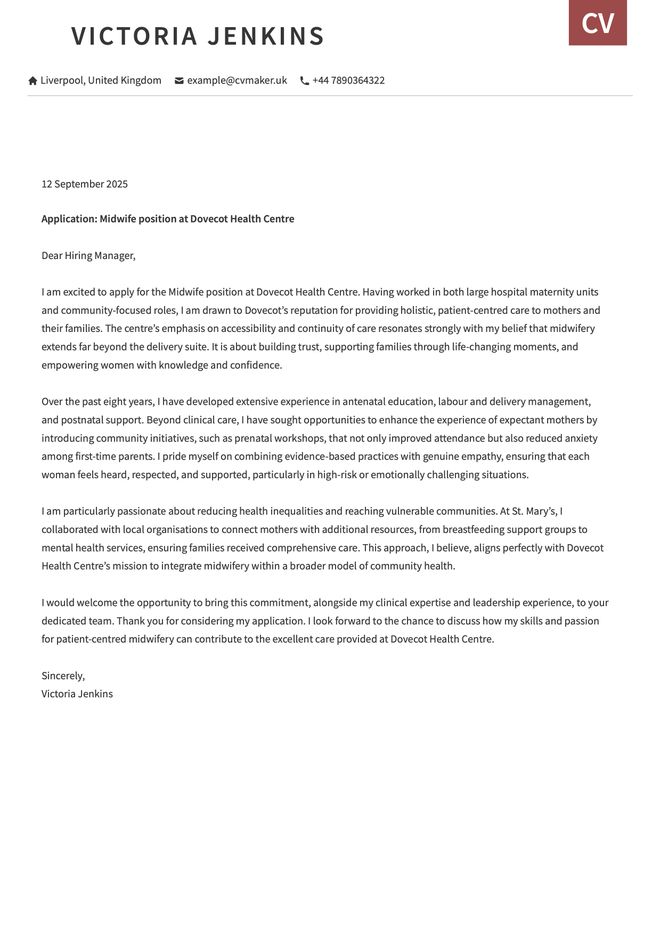


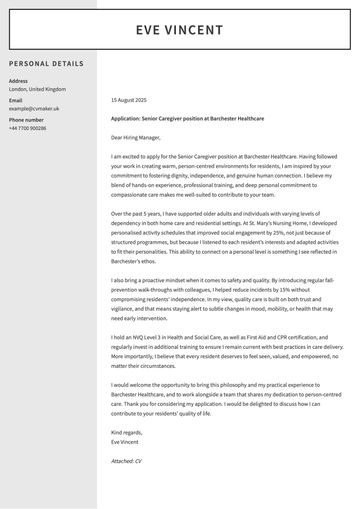



)
